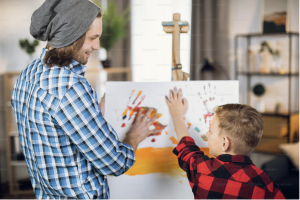Since 2018, Bobby has been an invaluable part of the Artlis Studios team, guiding children and adults through the therapeutic potential of art. With a background in facilitating life drawing sessions and years spent mentoring at-risk children within the school system, Bobby’s life has been deeply intertwined with the arts and emotional well-being.
Over the years, her passion for using art as a healing tool has grown, leading her to pursue a Bachelor of Art Psychotherapy. Today, as “Barefoot Bobby,” she runs her own art therapy practice, offering sessions at Artlis Studios and in private homes. Her journey is a testament to the deep connection between creativity and emotional health.

Bobby Napier of Barefoot Bobby
Art as an Emotional Regulator
One of the most powerful aspects of art therapy is its ability to regulate emotions, particularly for children who may struggle with anxiety or overwhelming feelings. At Artlis Studios, the team has observed how students who are anxious or upset often find solace in creative activities. But what is happening in the brain during these moments?
Bobby explains that our nervous system plays a key role.
The body’s autonomic nervous system has two primary parts: the sympathetic (responsible for fight or flight) and the parasympathetic (rest and digest). When we are stressed, the sympathetic nervous system is activated, preparing the body to either fight or flee from perceived danger.
Unfortunately, in our fast-paced world, this system can be triggered by non-threatening situations, such as a child fearing they’ll be called on in class. Art, however, activates the parasympathetic nervous system, allowing the body to relax and focus on the important peripheral roles It has, such as digestion and healing and good decision making, rather than reacting to stress.
Bobby describes this process as a “workout for the brain.”
Engaging in art activates multiple areas of the brain, including the limbic system, which processes emotions, and the prefrontal cortex, responsible for problem-solving and risk analysis. For children, whose prefrontal cortex doesn’t fully develop until their mid-late twenties, creative activities can help them learn how to engage their prefrontal cortex and create psychological flexibility—the ability to see multiple solutions to a problem.
The Power of Flow State
Achieving a “flow state” during creative activities can be transformative. Flow occurs when the task is challenging enough to engage the brain, but not so difficult that it causes frustration. “You lose track of time,” Bobby explains, “and it’s amazing for the brain.”
Whether it’s building a treehouse or painting a canvas, the flow state strengthens neural connections and provides a deep sense of fulfillment.
However, Bobby warns that striving for perfection or focusing too much on an outcome can hinder this process. “Art therapy differs from art learning in that there’s no expected result. The client’s process is what matters, not the product.”
The Deep Work of Art Therapy
At its core, art therapy is client-centred. Bobby emphasizes that the therapist is merely a facilitator, helping the client unlock their own insights through the creative process. This can lead to improved emotional regulation, reduced anxiety, and a stronger sense of self-understanding.
In our interview Bobby reflects on a young client who had been traumatized by the floods of 2022. The girl had a fear of rain that was impacting her daily life. Through a series of creative exercises, including writing and performing a hero song, the girl was able to confront her fear in a safe, supportive environment.
By externalizing her emotions and re-framing her relationship with rain, she regained control over her anxiety.
Art Therapy at Home
Even if you can’t see an art therapist, Bobby offers some practical tips for those seeking the benefits of creative expression at home. “Art doesn’t have to be complex or perfect to be therapeutic,” she advises.
Start with simple materials—pencils, paper, paint—and allow yourself to create without judgment. Whether it’s doodling, painting, or even crafting, letting go of expectations and embracing the act of creation can help calm the mind and offer a deeper sense of emotional clarity.
Finger painting, sponge painting, drawing self-portraits in the mirror, or simply doodling on a piece of paper—all of these are powerful ways to explore creativity. The true magic lies in embracing the process, not the final result. Let go of expectations and play, just like you did when you were three years old, allowing yourself the freedom to create without limits or judgment.
At Artlis Studios, Bobby continues to make a lasting impact, not only as an art therapist but as a nurturing presence for both children and adults. Her work reminds us of the powerful connection between creativity and emotional healing, and how, through art, we can all find a way to better understand ourselves and the world around us.
If you would like to get in contact with Bobby and book a session for yourself, you can do so by emailing bo*********@gm***.com
And if you’d like to hear the interview on our podcast, CHECK IT OUT HERE!
Have you heard about our new Friday afternoon Family Art Therapy Classes with Bobby?
Join Miss Bobby, our dedicated art therapist, for a weekly one-hour session where kids and parents explore a world of artistic expression. This class is designed to help you reconnect with your inner child, while also showing your little artist that creativity is about the process, not perfection. Together, you’ll work with a range of materials, including paint, markers, and more, to craft unique pieces that tell a story of growth, learning, and self-discovery.
Here, there are no mistakes—only possibilities. The focus is on experimentation, understanding how different colors evoke emotions, and using art as a tool for exploring feelings. By collaborating with your child, you’ll both embark on a meaningful creative journey, leaving behind the pressure of the “perfect” final product.

